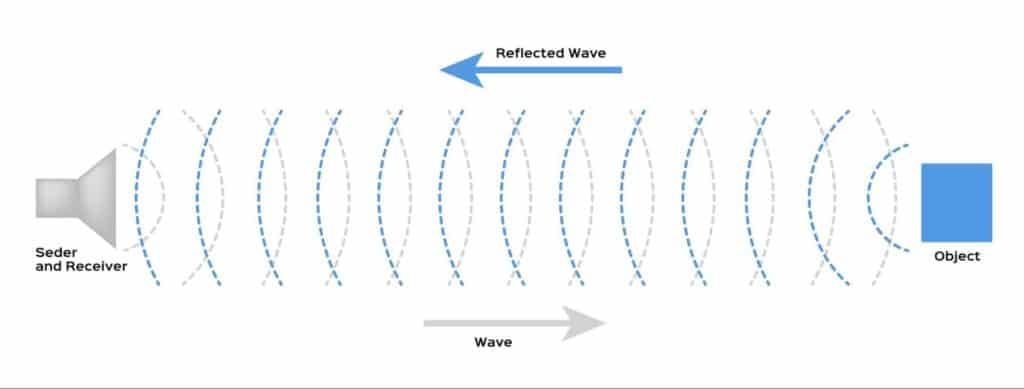What is Ultrasonic Testing?

Ultrasonic testing (UT) has uses in many industries—from aerospace to hydrocarbon exploration. By providing an efficient and accurate method for testing material for flaws, and thus paving a way for smarter, more targeted maintenance plans, ultrasonic testing can save companies time and money.
Companies leverage ultrasonic technology for their volumetric nondestructive testing (NDT) needs. The most advanced ultrasonic equipment is durable, often portable, accurate, and incredibly easy to use. An understanding of how ultrasonic technology has evolved over the years can aid in decisions regarding ultrasonic NDT in various industries.
What Is Ultrasonic Testing?
Ultrasonic testing is the introduction of high-frequency sound waves into a material to detect anomalies. Using a transducer (usually a probe), the sound waves interact with the material, sending off a different signal when they encounter a flaw. Where the material is smooth, with no obstacles, it’s likely free from flaws. The presence of corrosion, cracks, or any other flaw is signaled by a returned sound wave. The sound waves return a signal, in the form of a 3D visualization, that can tell the distance between each anomaly. With the use of advanced phased array ultrasonic testing (PAUT), the inspecting technician can obtain a complete visualization of the flaws within the material being testing.
For coarse grain materials that don’t lend themselves to UT, such as cast iron, there are other methodologies like eddy current testing that work better.
The History of Ultrasonic Testing
The principles of ultrasonic testing have been around for a long time. Ultrasound technology can be traced back to the study of acoustics—which fascinated Pythagoras (6th century BC)—because it’s the use of sound waves and how they interact with our physical world.
The modern usage of ultrasonic testing was first introduced in the aftermath of the sinking of the Titanic as engineers searched for ways to detect icebergs before they came into view. Relying on the echoes of sound waves sent through the water was considered one of the most promising methods of detecting objects that may be hazardous.
UT gained traction a few years later, though for precisely the opposite reason, as submarine warfare became a big part of WWI. Detecting and sinking submarines and other ships became a vital part of the war effort. This led to more research in the field that carried over into peacetime.
In 1928, a Soviet scientist named Sergei Y. Sokolov demonstrated a way to use soundwaves to detect flaws in metal; advances quickly followed. British engineers in the 1940s explored how ultrasonic could be used in steel and other metals. By 1950, companies in the United States and Japan were developing ultrasound testers for commercial use.
To say this technology is different from what we use today is an understatement. Original UT equipment consisted of huge, bulky vacuum tubes that were incredibly energy inefficient—in terms of consumption and the human energy it took to make them work.
It wasn’t until the 1960s that solid-state circuitry was advanced enough to create portable equipment. Even that used analog signal processing, which made the pictures less comprehensive and accurate (while still being incredible feats of engineering). By 1984, digital, portable, ultrasonic detectors had become a reality.
The State of Ultrasonic Testing Today
Today’s most advanced ultrasonic testing instruments have a slight resemblance to those that came before. The principles are the same but calibration stabilization, measurement precision, imaging and data sharing have advanced leaps and bounds.
In its form today, ultrasonic testing:
- Detects both surface and subsurface anomalies
- May only require a single side for entrance
- Often requires minimal part preparation
- Can provide instant results
- Allows for results to be shared easily
- Lends itself to automation, saving user energy
The precision of ultrasonic testing may require that technicians be trained before using an instrument. And, the more advanced the equipment, the more training and support benefits the user. Most companies choose to work with an ultrasonic testing instrument provider who also provides in-depth training and support.
Efficient Ultrasonic Testing
Ultrasonic testing is most capable of detecting early occurrences that could jeopardize operations within the power generation, railway, and aerospace industries, for example. The decision to use an ultrasonic testing technique over another lies in how easily, quickly, and accurately the inspection can be performed. In addition to speed and accuracy, the best ultrasonic inspection equipment affords enhanced safety and asset longevity. As ultrasound technology continues to advance, it’s essential to work with a provider that offers the most efficient instrumentation.
Zetec provides exceptional ultrasound testing equipment for nearly every industry. To find the NDT equipment which best suits your testing needs, contact us today!





